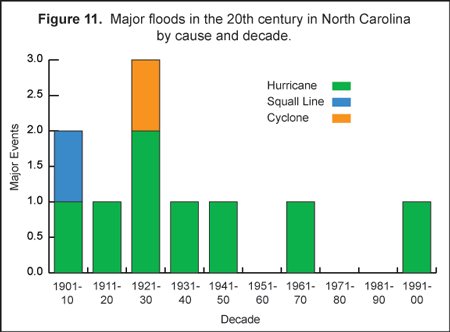The floods associated with the tremendous amounts of rainfall from hurricanes Dennis and Floyd were truly unusual events, with widespread flooding over almost all of the Coastal Plain. The previous major flood was in 1964 (Figure 11) and even that was confined mainly to the southern mountains and the Neuse river basin. The last time most of the Coastal Plain was inundated was back in 1945, when it was also back-to-back hurricanes which were responsible for the rain that created the floods. Indeed, it is usual for major floods to be created by two events in sequence. At least one is usually a hurricane. As a result, it is not coincidence that the frequency of major flooding reflects the distribution of hurricane frequency. And these widespread floods usually occur in the late summer or Fall. The only ones not involving hurricanes were the 1928 flood, which affected the mountains and southern Piedmont and was the result of a very wet period soaking the ground followed by a slow-moving, vigorous frontal storm, and the flood of 1901. This latter, which affected the Catawba and the valleys farther west, was caused by a pair of what were then called squall lines, having the characteristics of what we would now identify as weather fronts. Hurricanes do not seem to have been involved.

Most floods, of course, are much less spectacular and widespread than those associated with Dennis and Floyd, although they can be equally destructive in the area affected. Many are flash floods created when a summer thunderstorm pours a great deal of water onto a single river basin in a short period of time (see figure 2.17 in The North Carolina Atlas). Also common, especially in the mountains, are winter flash floods that occur when intense rain falls on frozen ground. In general, it is extremely difficult to determine whether these are increasing or decreasing in frequency. They are only recorded when someone sees them, or when a river-flow gauge is operating. So, population changes influence the reports and one would perhaps expect an increasing number of floods simply because there are now more people to see them. In addition, development in the basins should, theoretically, increase the tendency to flood, while flood control structures have been built to minimize the impact of sudden downpours of rain. As a result, the actual causes of any trends that might occur are not clear. Nevertheless, from time to time there are certainly sets of flash floods similar to those which occurred in the mountains in January, 1998 (Figure 2). Soils at high elevations were frozen, those lower down were saturated with water. A slow-moving cyclonic storm put about 4 inches of rain over much of the area, with almost 15 inches falling in isolated high elevations. This created what would have been a fairly common set of floods for the mountains in winter. Then a line of thunderstorms came through, adding even more water, so that several places in Avery, Mitchell and Yancey counties reported that a wall of water rushed downstream. High water levels and the force of the water created much destruction in the valleys. Even away from the valley floors, winds associated with the storms uprooted many trees from the sodden ground, increasing the damage. The result was, for many areas, a storm which was the "worst since 1977".